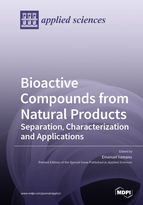Bioactive Compounds from Natural Products: Separation, Characterization and Applications
A special issue of Applied Sciences (ISSN 2076-3417). This special issue belongs to the section "Applied Biosciences and Bioengineering".
Deadline for manuscript submissions: closed (20 January 2022) | Viewed by 43744
Special Issue Editor
Interests: microbiota; oxidative stress; in vitro; antioxidant; natural compounds; fermentation; healthy beverages; vegan supplements; non dairy products
Special Issues, Collections and Topics in MDPI journals
Special Issue Information
Dear Colleagues,
This issue aims to publish new and innovative research that could demonstrate the therapeutic potential of natural health products by in vitro and/or in vivo biological activities relevant to prevent or to alleviate degenerative diseases. Natural extracts or functional foods (including byproducts) could be valorized to obtain new products. Still, one of the main problems is regarding the poor bioavailability or low correlation between in vitro and in vivo activities (antioxidant, anti-inflammatory or antimicrobial). The interaction of natural health products with human microbiota represents an essential aspect because it could modulate the microbial pattern and alleviate more of the chronic disease’s effects in case of type 2 diabetes, cardiovascular dysfunctions, neurodegenerative diseases, and inflammatory colon pathologies.
Additionally, you are invited to send research/reviews based on the effect of different extracts or functional foods used in degenerative pathologies and interactions with human microbiota. We aim to identify new data on in vitro/in vivo research that could demonstrate the bioavailability of natural compounds (such as yeasts) and the relation with antioxidant/antimicrobial capacity. Modulated microbiota aspects are expected to be published, based on the interaction with natural compounds, natural sweeteners (like stevia) or other molecules that influence the colon health status. We would like to encourage you to send papers and other related aspects relevant to the issue topic.
Dr. Emanuel Vamanu
Guest Editor
Manuscript Submission Information
Manuscripts should be submitted online at www.mdpi.com by registering and logging in to this website. Once you are registered, click here to go to the submission form. Manuscripts can be submitted until the deadline. All submissions that pass pre-check are peer-reviewed. Accepted papers will be published continuously in the journal (as soon as accepted) and will be listed together on the special issue website. Research articles, review articles as well as short communications are invited. For planned papers, a title and short abstract (about 100 words) can be sent to the Editorial Office for announcement on this website.
Submitted manuscripts should not have been published previously, nor be under consideration for publication elsewhere (except conference proceedings papers). All manuscripts are thoroughly refereed through a single-blind peer-review process. A guide for authors and other relevant information for submission of manuscripts is available on the Instructions for Authors page. Applied Sciences is an international peer-reviewed open access semimonthly journal published by MDPI.
Please visit the Instructions for Authors page before submitting a manuscript. The Article Processing Charge (APC) for publication in this open access journal is 2400 CHF (Swiss Francs). Submitted papers should be well formatted and use good English. Authors may use MDPI's English editing service prior to publication or during author revisions.
Keywords
- product administration
- bioavailability by alternative methods
- polyphenols
- yeasts
- antioxidant
- extraction






